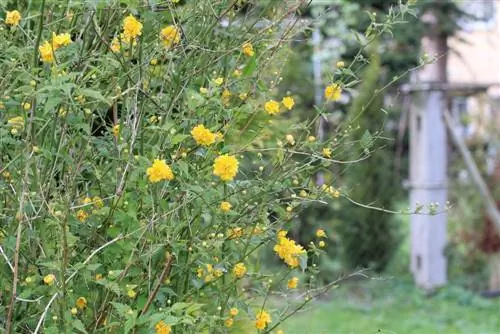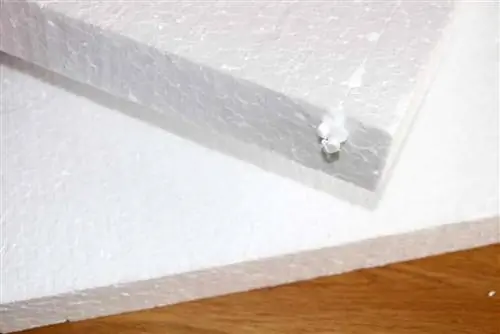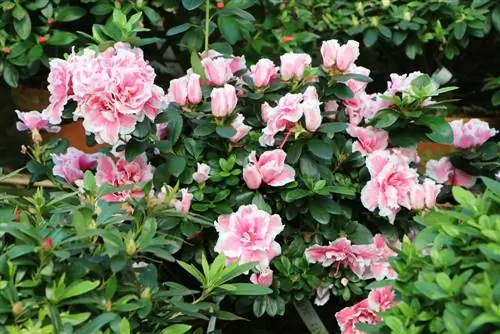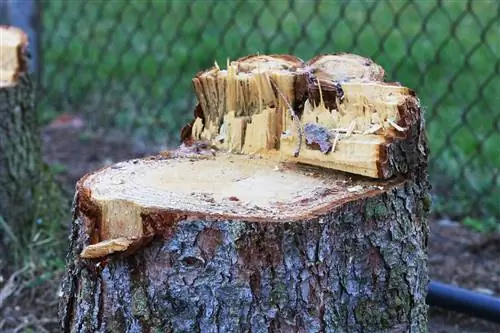- Author admin [email protected].
- Public 2023-12-17 03:39.
- Last modified 2025-01-24 12:45.
The raununculus bush is originally native to Japan and China. It impresses with its overhanging branches and early abundance of flowers. In order to thrive, it needs a partially shaded spot with normal garden soil. If it is well cared for and cut, it will constantly rejuvenate itself with new growth and will be an eye-catcher in the garden for years to come. A double ranunculus bush is particularly impressive, attracting the viewer's attention with its yellow flower balls.
When is the best time to cut the ranunculus bush?
The best time to cut a golden rose is late spring. Shortly after flowering, old, woody and diseased branches can be removed just above the ground. With this intervention the shrub is rejuvenated. New shoots grow from the “sleeping eyes” of the remaining branch stump, which then bear flowers the next spring. Ideally, the shrub will bloom a second time in the fall. Afterwards, you can photograph again if necessary.
When and how should the ranunculus bush be cut?
A radical pruning is not recommended for the golden rose. If all the shoots are shortened significantly at once, the lower part of the bush will become bare after a while. Regular but moderate thinning of the older branches (older than two years) shortly after flowering stimulates the plant to form new shoots. This care measure keeps the shrub young and strong.
A topiary is also not suitable for the ranunculus bush. If its delicate, hanging branches are brought into an unnatural shape, the entire appearance of the shrub suffers. The ability to bloom will decrease because the young branches bearing flowers will also be removed or shortened too much.
Tip:
When thinning out, cut off the corresponding branches directly at the base.
Types of pruning
When cutting the ranunculus bush, there are these cutting options:
Blending cut
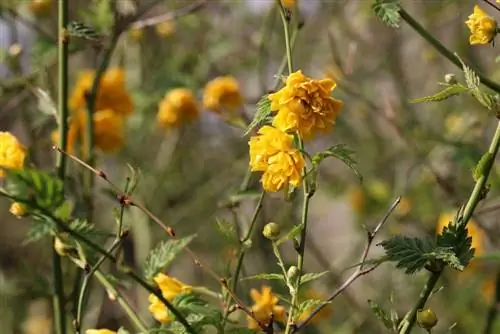
Immediately after flowering, on a dry day with little sun, the single and double ranunculus bushes are carefully pruned. This is a thinning cut. Branches that are older than two years old as well as diseased and crossing shoots are removed. Withered flowers can also be cut off to encourage the bush to bloom again in autumn.
Rejuvenation cut
If the ranunculus bush has not been cut for years, the plant will age. The lower areas become heavily woody, have few leaves and only a few flowers appear on the hanging branches. Then at the latest it is time for a rejuvenation cut or radical cut. The plant is radically shortened so that new shoots can develop from the “sleeping eyes” of the branch stumps just above the ground.
The optimal time for a rejuvenation cut is a frost-free period in January or February. Now you can radically cut the old and woody branches. Diseased and inwardly growing trees are also rigorously trimmed.
For a relatively long time, the golden rose will look bare and plucked, because the shrub needs a few months to recover from the radical pruning. It is therefore much better for the shrub and also for the overall appearance of the garden to take the time for regular and gentle thinning.
hedge cutting
The simple ranunculus bush as well as a double ranunculus bush are suitable as an impressive solitary plant, but also for planting a flower hedge. This should be allowed to grow freely and not be cut into a special shape. However, you need sufficient space for a freely growing hedge.
vase cut
The golden yellow flowers of the ranunculus bush bring the right spring mood to your garden every year. Immediately after the buds have bloomed, cut some stems for the vase and bring the sun into your home. The shrub doesn't mind such small cuts.
Tip:
Leave about 10 cm of the branch. The golden rose will quickly sprout again at the cut point.
When is the right time to trim your hedge?
So that the golden rose retains its shape in a hedge planting and does not grow out of control, it is necessary to cut it twice a year. For the first time, as with a solitary shrub, the old and diseased branches are removed in early spring and excessively long shoots are shortened. You should move the second cutting date to autumn. Since buds are already developing for spring blooms, only protruding branches need to be cut.
Cut to avoid overgrowth
It is in the nature of the ranunculus bush to spread vigorously and take up as much space as possible. To do this, the plant permanently forms runners, which must be cut to avoid uncontrolled growth.
Tip:
When planting the golden rose, put a root barrier in the planting hole. This will prevent it from spreading unhindered.
How should the cut be done step by step?
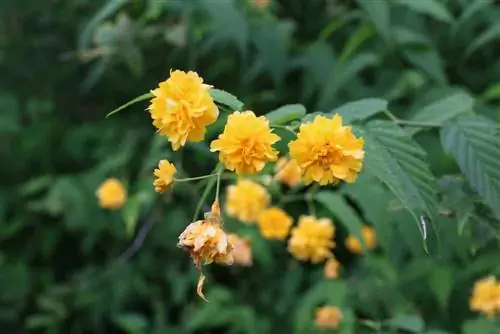
If the gardener wants to cut his ranunculus bush correctly, there are a few rules to follow. This is the only way the shrub retains its natural shape and produces its wonderful abundance of flowers year after year.
old wood
Old shoots have brown bark. Here no more buds develop in the upper areas. Therefore, these branches are cut about ten centimeters above the ground. Now new shoots can sprout from the “sleeping eyes” in the stump, which will then bear flowers again.
Jungholz
Young shoots can be recognized by their fresh, green bark. If they have grown too long and obscure other trees, they can be shortened to the desired length, but by a maximum of a third. The cut is made just above a leaf node. New branches then emerge here, which then bear flowers again.
The right tool
Good quality tools are required for pruning trees and bushes. The blades must be sharp and, above all, clean. To avoid germs or fungal spores getting into the cuts on the branch, clean your tools with alcohol before starting work.
The bypass secateurs
These are one-handed scissors whose blade and counter-blade are made of hardened steel. When cutting, you get a smooth cut surface on the branch that closes quickly and prevents bacteria or viruses from entering.
The anvil secateurs
Here a sharp blade meets a smooth surface. When cutting, press the branch onto the surface and cut through it in this way. The branch suffers bruises. Cracks appear in the wood and the cut surface becomes frayed. Disease germs can now penetrate here and cause considerable damage to the shrub. Therefore, these scissors are not suitable for cutting delicate branches.
What mistakes should you avoid?
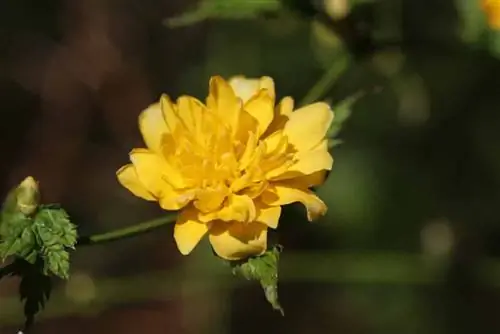
The ranunculus bush is a robust representative of its kind. Beginners when pruning trees don't have to worry about doing anything wrong. There is no special pruning technique for this shrub. If too much is cut off or cut too deep, no permanent damage will occur. The bush regenerates and sprouts again quickly.
Should you cut off spent flowers?
When the flowers of the ranunculus bush fade, small seeds are produced. These contain glycosides, which cause nausea and vomiting when consumed in large quantities. If there are children or animals in the household, you must remove the wilted flowers immediately to avoid possible poisoning.

